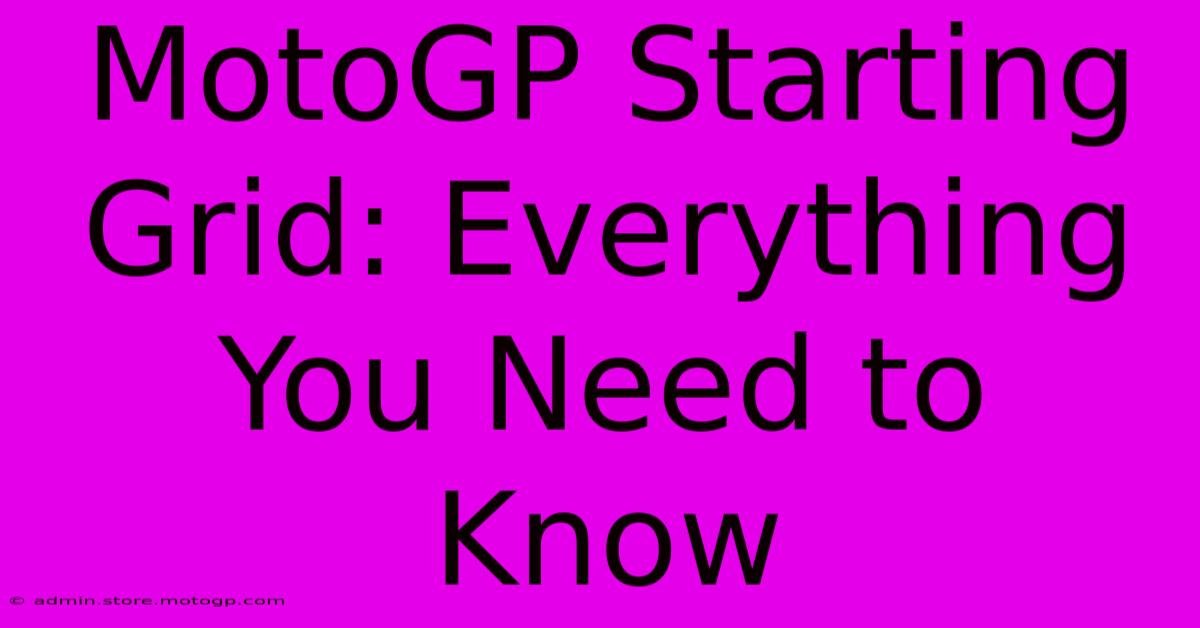MotoGP Starting Grid: Everything You Need To Know

Table of Contents
MotoGP Starting Grid: Everything You Need to Know
The roar of the engines, the smell of burning rubber, the heart-stopping acceleration… MotoGP is a spectacle of speed and skill, and a crucial element of that spectacle is the starting grid. Understanding how the grid is formed is key to appreciating the nuances of the race and the strategic decisions that shape it. This article dives deep into the MotoGP starting grid, explaining everything you need to know.
How is the MotoGP Starting Grid Determined?
The starting grid for a MotoGP race isn't random; it's meticulously determined through a series of qualifying sessions, designed to showcase the riders' skill and their machines' performance. The process typically involves:
Free Practice (FP):
- FP1 & FP2: These sessions are crucial for teams to gather data, test different setups, and get a feel for the track conditions. While they don't directly impact grid position, the data collected is invaluable for optimizing performance in qualifying. Teams use this time to experiment with tire compounds, suspension settings, and aerodynamic configurations.
Qualifying (Q):
-
Q1: The riders with the slowest combined times from the Free Practice sessions compete in Q1. The top two riders from Q1 then progress to Q2. This session is crucial for those riders fighting for a better grid position. Even a small improvement can mean the difference between starting in the front or the middle of the pack.
-
Q2: The top 10 riders from FP, combined with the two fastest riders from Q1, compete in Q2. The starting grid positions are determined based on the fastest lap times achieved during Q2. This is where the intense competition really heats up, as riders push their machines and themselves to the absolute limit. Each tenth of a second counts, often deciding the difference between a front-row start and a mid-grid position.
Understanding the Starting Grid Positions
The MotoGP starting grid is arranged in rows of three, with the fastest rider in Q2 taking pole position – the coveted spot at the front of the grid. The significance of starting position cannot be overstated; it often dictates the race outcome.
-
Pole Position: The rider with the fastest lap time in Q2 earns pole position, placing them at the forefront of the pack. A pole position start gives a rider a significant advantage, allowing them to lead the race and control the pace from the outset. It's a huge boost to a rider's confidence and often sets the tone for the race.
-
Front Row: The top three riders occupy the front row, enjoying prime racing positions. These riders have a significant strategic advantage, allowing them to dictate the race and control their competitors. The front row start is highly coveted and offers the best chance for a race victory.
-
Second and Third Rows: These positions are still advantageous but require more aggressive racing to move up the field. Riders starting from these positions will need to navigate the chaos of the initial laps and be quick and decisive in their overtaking maneuvers.
-
Back of the Grid: Starting further back means a much tougher battle for the finish line. Overtaking is challenging in MotoGP, requiring significant skill, timing, and a bit of luck. Riders from this region will need to execute perfect races, avoiding mistakes and being strategically opportunistic in their attempts to pass other racers.
The Importance of the Starting Grid
The MotoGP starting grid is more than just a lineup; it's a strategic battleground. A strong starting position significantly enhances a rider's chances of victory. It allows for cleaner racing lines, early control over the race pace, and a better opportunity to avoid the initial race incidents. However, even the most favorable starting position can't guarantee victory; skill, consistency, and strategic race management remain crucial for success.
Beyond the Grid: Factors Influencing Race Outcomes
While the starting grid plays a vital role, many other factors influence race outcomes. These include:
-
Race strategy: Tire choices, fuel management, and pit-stop strategies can greatly impact the final race results.
-
Rider skill and experience: Exceptional riding talent allows drivers to make up for a less-than-ideal starting position.
-
Bike performance and reliability: Mechanical problems or a less-competitive machine can negate even the best starting positions.
-
Weather conditions: Changes in weather can significantly affect race dynamics and make the starting grid positions far less predictive.
Understanding the complexities of the MotoGP starting grid adds a new layer of appreciation for this high-octane sport. It's a testament to the skill, precision, and strategic thinking required to succeed in the world of MotoGP.

Thank you for visiting our website wich cover about MotoGP Starting Grid: Everything You Need To Know. We hope the information provided has been useful to you. Feel free to contact us if you have any questions or need further assistance. See you next time and dont miss to bookmark.
Featured Posts
-
Moto 2 Specs That Set The Standard
Feb 18, 2025
-
Experience The Freedom Of Speed Cota Track Day
Feb 18, 2025
-
Motorcycle Racing The Mental Game For Different Race Types
Feb 18, 2025
-
The Secret To Easy Cota Parking
Feb 18, 2025
-
Secure Your Cota Grandstand Seat Dont Miss Out
Feb 18, 2025
